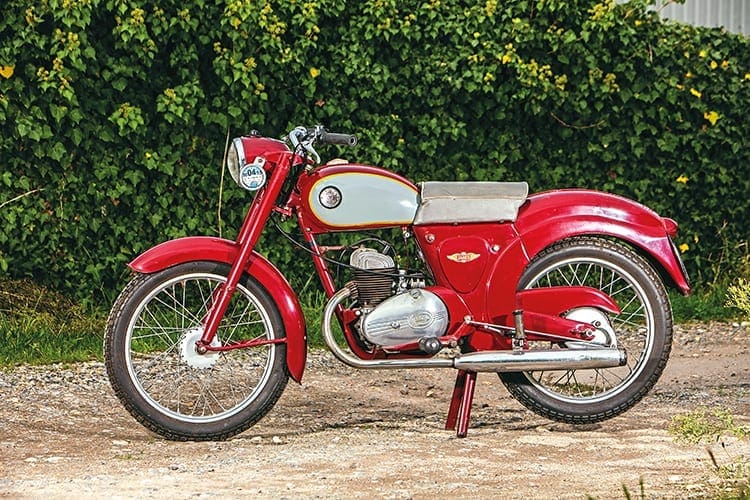
This little James has never left the area in which it was bought when new, serving several owners, just a few miles apart, well.
In 1958 the hula-hoop was invented, rock star Elvis Presley topped the charts with ‘Jailhouse Rock,’ Wolves won English football’s first division and in the UK the price of an average house was £2390. Young TV viewers saw the launch of Blue Peter, or if you were a budding motorcyclist the weekly press was full of the launch of the new Ariel Leader two-stroke twin and BSA’s single-cylinder C15. Some buyers’ aspirations of personal transport were slightly more modest and down at Pankhurst Motorcycles in Weymouth on May 23, 1958, Elwin Graham handed over his £101-13s-7d and took charge of a brand new 150cc James Cadet.
Enjoy more Classic MotorCycle reading in the monthly magazine.
Click here to subscribe & save.
Elwin can’t have imagined that 60 years on, his James would still be running with just over 13,000 miles showing on the clock, and that four owners later it would still be in Dorset, the county where it was first registered. Still in its original red and grey livery, the little James is now owned by West Country enthusiast Ron Axon, a man who has been motorcycling for more than 70 years and one who loves unrestored machines. The Cadet is now part of an impressive collection of British and Japanese bikes that have come Ron’s way, although most of them have cost little money – he was actually given the 150cc two-stroke 20 years ago.
Before we hear from him about how he acquired the Cadet, perhaps it’s time to reflect on the launch of the new model in 1956. From the James factory at Greet in Birmingham the first Cadet had appeared in 1950. This version continued until 1953 when it was replaced by a utility model, numbered J5, powered by a Villiers 13D engine featuring a new frame with plunger rear suspension and simple telescopic front forks using springs as the suspension medium, while for those who wanted a bit more luxury there was also a deluxe version that offered a dual seat as an optional extra.
In 1955 the J5 was replaced by the J15 but the only real change was that the larger 30C engine was fitted, although there were also alterations to the handlebar fixings and the headlamp shell, which was lengthened to take the speedometer, lighting switch and ammeter. Like the rest of the James range, the Cadet was also fitted with full width brake hubs but it had to wait until the following year when the new model – similar to the one we have on test – appeared. The design team at the south Birmingham factory had come up with a new frame built from tubes and pressings, with the rear swinging arm controlled by a pair of forward mounted springs hidden by the centre enclosure and covered by the deeply valanced rear mudguard – one that to the casual modern observer looks a bit like a monoshock rear suspension system.
In addition, the lightweight stroker was also fitted with a new set of telescopic forks with tension springs and compression oil damping and a very quiet alloy expansion chamber mounted beneath the gearbox with twin tailpipes. A single rider’s seat went on top of the rear enclosure panelling and for those wishing to take a passenger, an extra seat and pillion rests could be added to the 150cc single. Such a machine was put through a lengthy road test by Motor Cycling in April 1956 and it lavished plenty of praise on the Greet company’s new arrival. The following is a precis of some of their remarks…
“The concept of the beam-cum-pressed-steel frame and the highly efficient silencer shows progressive outlook; redesigned too are the front and rear assemblies… Undoubtedly the advanced layout of the Cadet’s silencing system has brought the machine into line with many continental two-strokes now renowned for a quiet exhaust tone… Appealing to the eye, the deep rear mudguard forms an extension of the centre section to which it is bolted and sweeps in a graceful arc over the back wheel… The result is very clean lines blemished by clipped-on accessories. The black and red bi-chrome seat was supple and comfortable.”
They were equally complimentary regarding the bike’s impeccable starting – described it as ‘of the highest order’ – and also the braking, though there was some criticism of the gear ratios on the three speed box.
“During city trips first gear seemed too low and resulted in over-revving and, conversely, second seemed rather high. Inevitably, this resulted in frequent ‘cog swapping.’ The top gear in the three-speed box was usually selected at 36mph but steady acceleration, free from transmission snatch, was forthcoming from 22mph… Cruising speed in the region of 45mph was employed regularly and, fully run-in, the Cadet’s near maximum speed of 50mph could be held without distress to the power unit.”
Read the full story in The Classic MotorCycle August 2018
Advert
 Enjoy more The Classic MotorCycle reading in the monthly magazine. Click here to subscribe.
Enjoy more The Classic MotorCycle reading in the monthly magazine. Click here to subscribe.



